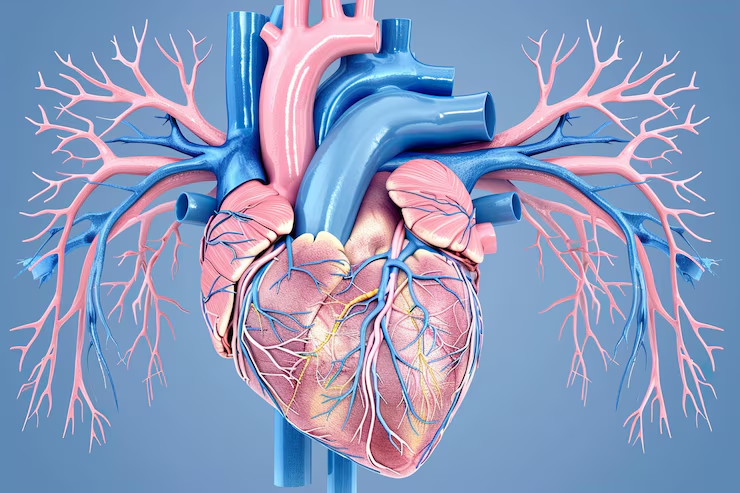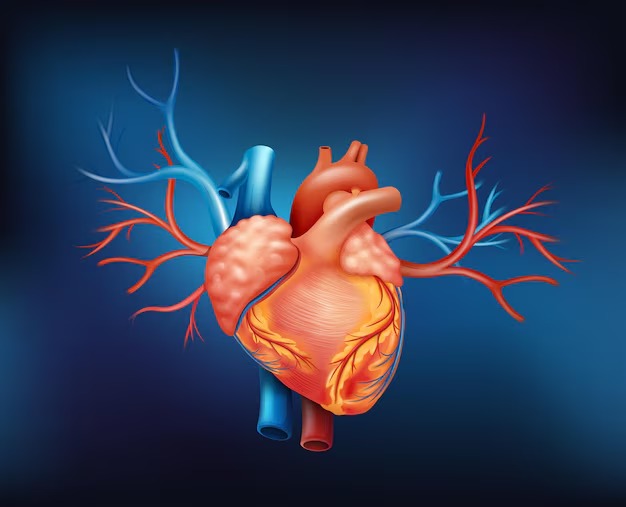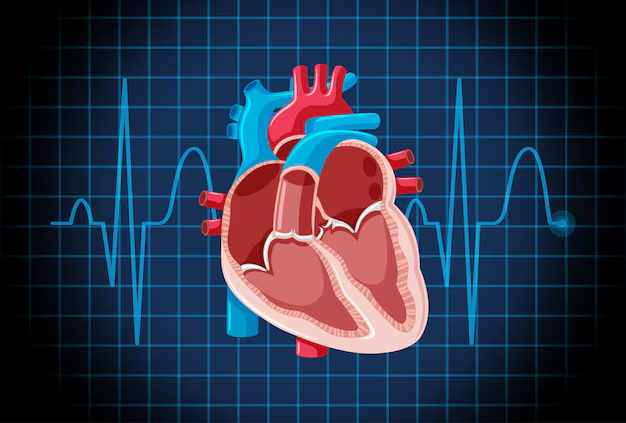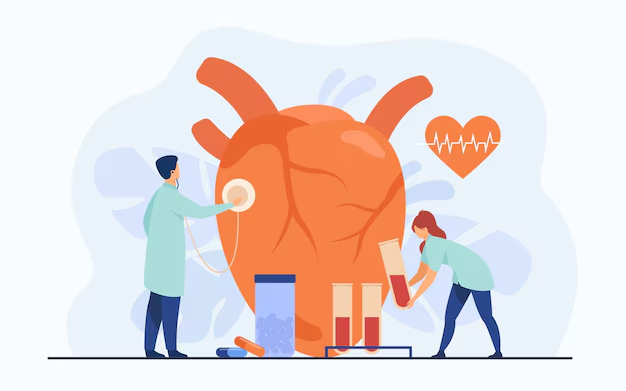The Human Heart: Structure, Function, and Importance

Introduction
The human heart is a muscular organ central to the circulatory system. It pumps blood throughout the body, delivering oxygen and nutrients to tissues while removing waste products. Often associated with emotions and vitality, the heart is biologically the engine that keeps us alive. Understanding its structure, function, and how to keep it healthy is essential for a long and vibrant life.
Anatomy of the Heart
Location and Size
The heart is located slightly left of the center of the chest, in the thoracic cavity between the lungs. It’s roughly the size of a clenched fist and weighs about 250–350 grams (8–12 ounces) in an average adult.
External Structure
The heart is encased in a protective sac called the pericardium, which contains a small amount of fluid to reduce friction as the heart beats. It has three main layers:
- Epicardium – outer layer
- Myocardium – muscular middle layer responsible for contractions
- Endocardium – inner lining of the heart chambers
Chambers of the Heart
The heart has four chambers:
- Two atria (upper chambers): right atrium and left atrium
- Two ventricles (lower chambers): right ventricle and left ventricle
Each chamber plays a distinct role in circulating blood.

Blood Flow Through the Heart
Double Circulatory System
The heart supports a double circulatory system:
- Pulmonary circulation (between the heart and lungs)
- Systemic circulation (between the heart and the rest of the body)
Step-by-Step Blood Flow
- Deoxygenated blood from the body enters the right atrium via the superior and inferior vena cava.
- Blood flows into the right ventricle, which pumps it to the lungs via the pulmonary arteries.
- In the lungs, blood picks up oxygen and releases carbon dioxide.
- Oxygenated blood returns to the left atrium via pulmonary veins.
- Blood moves into the left ventricle, which pumps it through the aorta to the entire body.
Heart Valves and Their Functions
There are four main heart valves, ensuring blood flows in one direction:
- Tricuspid valve – between right atrium and right ventricle
- Pulmonary valve – between right ventricle and pulmonary artery
- Mitral (bicuspid) valve – between left atrium and left ventricle
- Aortic valve – between left ventricle and aorta
These valves prevent backflow and maintain efficient circulation.
Electrical Conduction System
The Heart’s Natural Pacemaker
The heart has a built-in electrical system that controls the heartbeat. The sinoatrial (SA) node, located in the right atrium, acts as the natural pacemaker, initiating impulses that cause the heart to beat.
Conduction Pathway
- SA node initiates electrical signals.
- Impulses spread across atria, causing them to contract.
- Signals pass to the atrioventricular (AV) node.
- The AV node delays the signal slightly to allow ventricles to fill.
- The signal travels through the bundle of His, bundle branches, and Purkinje fibers, causing ventricles to contract.
Functions of the Heart
- Pumping Blood: Primary function—supplying oxygen and nutrients to tissues.
- Removing Waste: Carbon dioxide and metabolic waste are transported to organs for disposal.
- Maintaining Blood Pressure: The heart adjusts force and rate of pumping based on body needs.
- Endocrine Function: The heart releases hormones like atrial natriuretic peptide (ANP), which helps regulate blood volume and pressure.

Heart Rate and Cardiac Output
Normal Heart Rate
A normal adult resting heart rate is about 60 to 100 beats per minute (bpm). Athletes may have a resting rate below 60 bpm due to more efficient heart function.
Cardiac Output
Cardiac output is the volume of blood the heart pumps per minute. It’s calculated as:
Cardiac Output = Heart Rate × Stroke Volume
Where stroke volume is the amount of blood ejected by the left ventricle in one contraction.
Diseases of the Heart
1. Coronary Artery Disease (CAD)
Occurs when arteries supplying the heart muscle become narrowed or blocked due to atherosclerosis (plaque buildup). It can lead to:
- Angina (chest pain)
- Heart attacks (myocardial infarctions)
2. Heart Failure
A condition where the heart cannot pump enough blood to meet the body’s needs. It doesn’t mean the heart has stopped but that it’s weaker than normal.
3. Arrhythmias
Irregular heartbeats due to faulty electrical signaling. Types include:
- Bradycardia (too slow)
- Tachycardia (too fast)
- Atrial fibrillation (irregular rhythm)
4. Cardiomyopathy
A disease of the heart muscle making it harder to pump blood. It may be caused by genetics, high blood pressure, or infections.
Irregular heartbeats due to faulty electrical signaling. Types include:
- Bradycardia (too slow)
- Tachycardia (too fast)
- Atrial fibrillation (irregular rhythm)
4. Cardiomyopathy
A disease of the heart muscle making it harder to pump blood. It may be caused by genetics, high blood pressure, or infections.
5. Congenital Heart Defects
Structural issues present from birth, such as septal defects (holes in the heart), affecting normal blood flow.
Diagnostic Tests for Heart Health
- Electrocardiogram (ECG or EKG): Records electrical activity
- Echocardiogram: Ultrasound to view heart structure and function
- Stress Test: Measures heart performance under exertion
- Cardiac Catheterization: Invasive test to examine coronary arteries
- MRI and CT scans: Provide detailed heart images

Preventing Heart Disease
1. Healthy Diet
Consume:
- Fruits, vegetables, whole grains
- Lean proteins (fish, poultry, legumes)
- Healthy fats (olive oil, nuts)
Limit:
- Saturated fats
- Trans fats
- Sodium and added sugars
2. Regular Exercise
At least 150 minutes of moderate aerobic activity per week helps strengthen the heart, improve blood flow, and lower blood pressure.
3. Avoid Smoking
Smoking damages blood vessels, raises blood pressure, and significantly increases heart disease risk.
4. Control Blood Pressure and Cholesterol
High blood pressure and cholesterol are silent killers. Regular checkups, dietary changes, and medication (if necessary) can manage them.
5. Maintain a Healthy Weight
Obesity increases strain on the heart and is linked to high blood pressure, diabetes, and heart disease.
The Emotional and Symbolic Role of the Heart
While scientifically the heart is a muscular organ, across cultures it symbolizes:
- Love and compassion
- Courage and strength
- Emotion and intuition
These associations reflect the deep connection humans have made between heart rhythms and emotional states.
Heart Transplants and Artificial Hearts
Heart Transplants
For patients with end-stage heart failure, a heart transplant may be the only option. Despite advancements, challenges include organ availability and risk of rejection
.
Artificial Hearts and Devices
Devices such as Left Ventricular Assist Devices (LVADs) or total artificial hearts can support or replace heart function temporarily or permanently.
Recent Advances in Cardiology
1. Regenerative Medicine
Stem cell research and tissue engineering aim to repair damaged heart tissue or even grow heart tissue in labs.
2. Wearable Tech and Monitoring
Smartwatches and portable ECG devices allow early detection of arrhythmias and continuous monitoring of heart health.
3. Precision Medicine
Genetic testing and personalized therapies target individual risk factors for more effective treatment.

Interesting Facts About the Heart
- The heart beats around 100,000 times a day.
- It pumps nearly 2,000 gallons of blood daily.
- A woman’s heart typically beats faster than a man’s.
- The “lub-dub” sound comes from the closing of valves.
- The heart can continue beating outside the body if supplied with oxygen.
Conclusion
The heart is more than just an organ—it is the foundation of life. Its complex structure and essential role in circulating blood keep every other system functioning. Understanding the heart, recognizing symptoms of disease, and adopting a heart-healthy lifestyle can help prevent serious conditions and ensure a longer, more active life.
Taking care of your heart today is one of the most important investments you can make for your future.
https://www.thehindu.com/children/hearty-tales/article67791884.ece
https://sypertimes.com/the-great-ashoka-legendary-leader-of-history/




